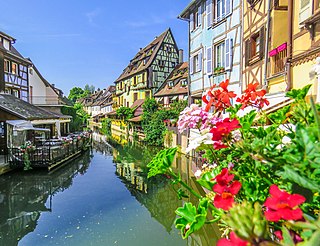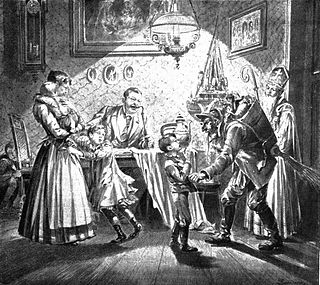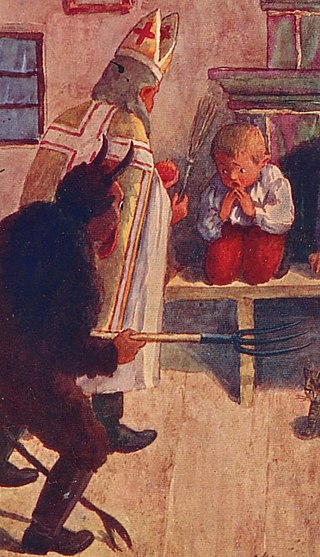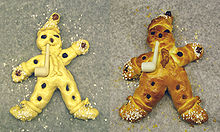
December is the twelfth and final month of the year in the Julian and Gregorian calendars. Its length is 31 days.

Alsace is a cultural region and a territorial collectivity in eastern France, on the west bank of the upper Rhine next to Germany and Switzerland. In January 2021, it had a population of 1,919,745. Alsatian culture is characterized by a blend of German and French influences.

Saint Stephen's Day, also called the Feast of Saint Stephen, is a Christian saint's day to commemorate Saint Stephen, the first Christian martyr or protomartyr, celebrated on 26 December in Western Christianity and 27 December in Eastern Christianity. The Eastern Orthodox churches that adhere to the Julian calendar mark Saint Stephen's Day on 27 December according to that calendar, which places it on 9 January of the Gregorian calendar used in secular contexts. In Latin Christian denominations, Saint Stephen's Day marks the second day of Christmastide.

Alsace–Lorraine, officially the Imperial Territory of Alsace–Lorraine, was a former territory of the German Empire, located in modern day France. It was established in 1871 by the German Empire after it had occupied the region during the Franco-Prussian War. The region was officially ceded to the German Empire in the Treaty of Frankfurt. French resentment about the loss of the territory was one of the contributing factors to World War I. Alsace–Lorraine was formally ceded back to France in 1920 as part of the Treaty of Versailles following Germany's defeat in the war, but already annexed in practice at the war's end in 1918.

Colmar is a city and commune in the Haut-Rhin department and Grand Est region of north-eastern France. The third-largest commune in Alsace, it is the seat of the prefecture of the Haut-Rhin department and of the subprefecture of the Colmar-Ribeauvillé arrondissement.

Belfort is a city in northeastern France, situated approximately 25 km (16 mi) from the Swiss border. It is the prefecture of the Territoire de Belfort.

Odile of Alsace, also known as Odilia and Ottilia, born c. 662 - c. 720 at Mont Sainte-Odile), is a saint venerated in the Catholic Church and the Eastern Orthodox Church. She is a patroness saint of good eyesight and of the region of Alsace.

The companions of Saint Nicholas are a group of closely related figures who accompany Saint Nicholas throughout the territories formerly in the Holy Roman Empire or the countries that it influenced culturally. These characters act as a foil to the benevolent Christmas gift-bringer, threatening to thrash or abduct disobedient children. Jacob Grimm associated this character with the pre-Christian house spirit which could be benevolent or malicious, but whose mischievous side was emphasized after Christianization. The association of the Christmas gift-bringer with elves has parallels in English and Scandinavian folklore, and is ultimately and remotely connected to the Christmas elf in modern American folklore.

Saint Nicholas Day, also called the Feast of Saint Nicholas, observed on 6 December ) in Western Christian countries, and on 19 December in Eastern Christian countries using the old church Calendar, is the feast day of Saint Nicholas of Myra; it falls within the season of Advent. It is celebrated as a Christian festival with particular regard to Saint Nicholas' reputation as a bringer of gifts, as well as through the attendance of church services.

Alamannia, or Alemania, was the kingdom established and inhabited by the Alemanni, a Germanic tribal confederation that had broken through the Roman limes in 213.

Saint-Louis is a commune in the Haut-Rhin department in Alsace in north-eastern France.

Saint Martin's Day or Martinmas, and historically called Old Halloween or Old Hallowmas Eve, is the feast day of Saint Martin of Tours and is celebrated in the liturgical year on 11 November. In the Middle Ages and early modern period, it was an important festival in many parts of Europe, particularly Germanic-speaking regions. In these regions, it marked the end of the harvest season and beginning of winter and the "winter revelling season". Traditions include feasting on 'Martinmas goose' or 'Martinmas beef', drinking the first wine of the season, and mumming. In some German and Dutch-speaking towns, there are processions of children with lanterns (Laternelaufen), sometimes led by a horseman representing St Martin. The saint was also said to bestow gifts on children. In the Rhineland, it is also marked by lighting bonfires.

Père Fouettard is a character who accompanies Saint Nicholas on his rounds during Saint Nicholas Day dispensing lumps of coal and/or beatings to naughty children while St. Nicholas gives gifts to the well behaved. He is known mainly in the far north and eastern regions of France, in the south of Belgium, and in French-speaking Switzerland, although similar characters exist all over Europe. This "Happy Father" was said to bring a whip with him to spank all of the naughty children who misbehaved.

Wimmenau is a commune in the Bas-Rhin department in Grand Est in north-eastern France.

Hésingue is a commune in the Haut-Rhin department in Alsace in north-eastern France. It is close to both the Swiss and German borders, and is around six kilometres from the centre of Basel.

A variety of customs and traditions are associated with Carnival celebrations in the German-speaking countries of Germany, Switzerland and Austria. They can vary considerably from country to country, but also from one small region to another. This is reflected in the various names given to these festivities occurring before Lent.

The Krampus is an old Christian character from old world Catholic Christmas traditions. The Krampus is one of the variations of St Nicholas’s helpers; a tradition where another character is assigned St Nicholas’s naughty list duties. The Krampus is a horned anthropomorphic goat figure with one human foot and a very long tongue who, in Central and Eastern Alpine folkloric tradition Christianity, is said to accompany Saint Nicholas on visits to children during the night of 5 December, immediately before the Feast of St. Nicholas on 6 December. The Krampus knocks on the doors of children’s homes to warn them to be good, or otherwise he will return on Christmas Eve with St. Nicholas. In this tradition, Saint Nicholas rewards well-behaved children with small gifts, while Krampus punishes badly-behaved ones with birch rods.

The cuisine of Baden is considered one of the best regional cuisines in Germany. Nationwide this region features the highest density of star-rated restaurants, similar to the neighbouring region Alsace which does the same for France.

Grand Est is an administrative region in northeastern France. It superseded three former administrative regions, Alsace, Champagne-Ardenne and Lorraine, on 1 January 2016 under the provisional name of Alsace-Champagne-Ardenne-Lorraine, as a result of territorial reform which had been passed by the French Parliament in 2014.

Gebildbrot is a bread or pastry in forms of figurative representations, such as a human, hare, bird or other braidings of dough. Traditionally this pastry is made for and consumed on certain feasts of the liturgical year.





















